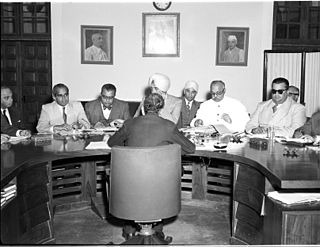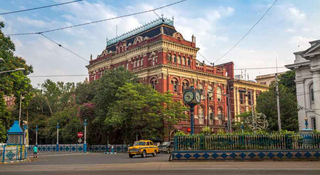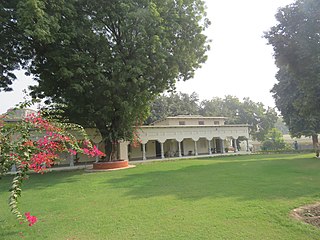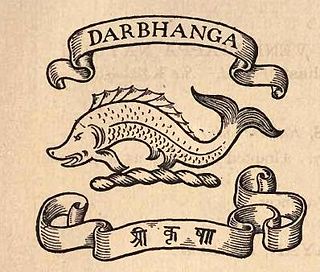Related Research Articles

Gwalior is a major city in the central Indian state of Madhya Pradesh; it lies in northern part of the state and is one of the Counter-magnet cities. Located 343 kilometres (213 mi) south of Delhi, the capital city of India, 120 kilometres (75 mi) from Agra and 414 kilometres (257 mi) from Bhopal, the state capital, Gwalior occupies a strategic location in the Gird region of India. The historic city and its fortress have been ruled by several historic northern Indian kingdoms. From the Kachchhapaghatas in the 10th century, Tomars in the 13th century, it was passed on to the Mughal Empire, then to the Maratha in 1754, and the Scindia dynasty of Maratha Empire in the 18th century. In April 2021, It was found that Gwalior had the best air quality index amongst the 4 major cities in Madhya Pradesh.

The University of Calcutta is the highest and 1st major public research university located in Kolkata, West Bengal, India. Considered one of best state research university all over India and every year CU topped among India's best universities. It has 151 affiliated undergraduate colleges and 16 institutes in Kolkata and nearby areas. It was established on 24 January 1857 and is the oldest multidisciplinary and European-style institution in Asia. Today, the university's jurisdiction is limited to a few districts of West Bengal, but at the time of establishment it had a catchment area, ranging from Lahore to Myanmar. Within India, it is recognized as a "Five-Star University" and accredited an "A" grade by the National Assessment and Accreditation Council (NAAC). The University of Calcutta was awarded the status of "Centre with Potential for Excellence in Particular Area" and "University with potential for excellence" by the University Grants Commission (UGC).
Events in the year 1911 in India.

Rajpramukh was an administrative title in India which existed from India's independence in 1947 until 1956. Rajpramukhs were the appointed governors of certain Indian provinces and states.

Darbhanga is the fifth-largest city and municipal corporation in the Indian state of Bihar situated centrally in Mithila region.
The three Round Table Conferences of 1930–1932 were a series of peace conferences organized by the British Government and Indian political personalities to discuss constitutional reforms in India. These started in November 1930 and ended in December 1932. They were conducted as per the recommendation of Muhammad Ali Jinnah to Viceroy Lord Irwin and Prime Minister Ramsay MacDonald, and by the report submitted by the Simon Commission in May 1930. Demands for Swaraj or self-rule in India had been growing increasingly strong. B. R. Ambedkar, Jinnah, Sir Tej Bahadur Sapru, V. S. Srinivasa Sastri, Sir Muhammad Zafrulla Khan, K. T. Paul and Mirabehn were key participants from India. By the 1930s, many British politicians believed that India needed to move towards dominion status. However, there were significant disagreements between the Indian and the British political parties that the Conferences would not resolve. The key topic was about constitution and India which was mainly discussed in that conference. There were three Round Table Conferences from 1930 to 1932.

St. Mary's Convent Inter College, Allahabad, Uttar Pradesh, India, is a girls school run by the Sisters of the Congregation of Jesus in collaboration with a lay staff members. It was founded in 1866 by Mother Mary Ward for the education of girls. The Delhi and the Lucknow campuses are co-educational.

B. B. D. Bagh, formerly called Tank Square and then Dalhousie Square, is the shortened version for Benoy-Badal-Dinesh Bagh. It is the seat of power of the state government, as well as the central business district of Kolkata in Kolkata district in the Indian state of West Bengal.

Vasant Panchami, also called Saraswati Puja in honor of the Hindu goddess Saraswati, is a festival that marks the preparation for the arrival of spring. The festival is celebrated by people of Dharmic religions in the South Asian countries in different ways depending on the region. Vasant Panchami also marks the start of preparation for Holika and Holi, which take place forty days later. The Vasant Utsava (festival) on Panchami is celebrated forty days before spring, because any season's transition period is 40 days, and after that, the season comes into full bloom.

Swaraj Bhavan is a large mansion located in Prayagraj India, best known for once being owned by the Indian political leader Motilal Nehru and being home to the Nehru family until 1930.
The Civil Lines is a residential area and one of the 3 subdivisions of the Central Delhi district of Delhi in India. It is one of the 12 zones under the Municipal Corporation of Delhi. It was the hub of European-style hotels in the city until New Delhi came into being in 1911. The official residence of the Lieutenant Governor of Delhi is also located at Raj Niwas Marg, Civil Lines.
The Old Allahabad City, at the south of Prayagraj Junction Railway Station, consists of neighborhoods like Chowk, Johnstongunj, Dariyabad, Khuldabad etc. and was in existence from the time of Akbar. Some magnificent structures erected in this era consist of the Khusro Bagh and the Allahabad Fort. In the north of Railway Station, the New Allahabad City consists of neighborhoods like Lukergunj, Civil Lines, Georgetown, Tagoretown, Bharadwaj Puram, Ashok Nagar, Mumfordgunj etc., which are relatively new and were built during the British rule. These neighborhoods reflect British architecture like the All Saints Cathedral, Alfred Park and Allahabad High Court. Newer residential areas include neighborhoods like Kareli and suburbs like Naini Jhunsi and Manauri bajar.

Prayag is an ancient holy city of India mentioned in the Vedic scriptures and texts. Prayag was renamed Allahabad by the Mughal ruler Akbar around 1575 or even later. Akbar was grandson of the Mughal conqueror Babur.
The Darbhanga Raj, also known as Raj Darbhanga and the Khandwala dynasty, was a Maithil Brahmins dynasty and the rulers of territories, not all contiguous, that were part of the Mithila region, now divided between India and Nepal.
Sir Gaṅgānāth Jhā was a scholar of Sanskrit, Indian philosophy and Buddhist philosophy.

Mithila, also known as Tirhut, Tirabhukti and Mithilanchal is a geographical and cultural region of the Indian subcontinent bounded by the Mahananda River in the east, the Ganges in the south, the Gandaki River in the west and by the foothills of the Himalayas in the north. It comprises certain parts of Bihar and Jharkhand of India and adjoining districts of the eastern Terai of Nepal. The native language in Mithila is Maithili, and its speakers are referred to as Maithils.

Maharaja Sir Lakshmeshwar Singh, Maharaja of Darbhanga was the Zamindar and principal landowner of Darbhanga in the Mithila region, presently in the State of Bihar, India. His philanthropic works, administrative abilities and management of his estate were highly appreciated and lead to development of his estate.
Bankipur is a neighbourhood and residential area in Patna, in the Indian state of Bihar. It is located on the bank of the river Ganges. The prime attraction is the Khuda Bakhsh Oriental Library built by Khan Bahadur Khuda Bakhsh in 1891 and Golghar granary that was built by Captain John Garstin in 1786. Patna Dental College and Hospital is also located here.
Maharajadhiraj Sir Kameshwar Singh Goutam Bahadur , K.C.I.E. was the Maharaja of Darbhanga. He held his title over his family estates in the Mithila region from 1929 – 1952, when such titles were abolished following the Independence of India. He had a sister Lakshmi Daiji.
Har Bilas Sarda (1867–1955) was an Indian academic, judge and politician. He is best known for having introduced the Child Marriage Restraint Act (1929).